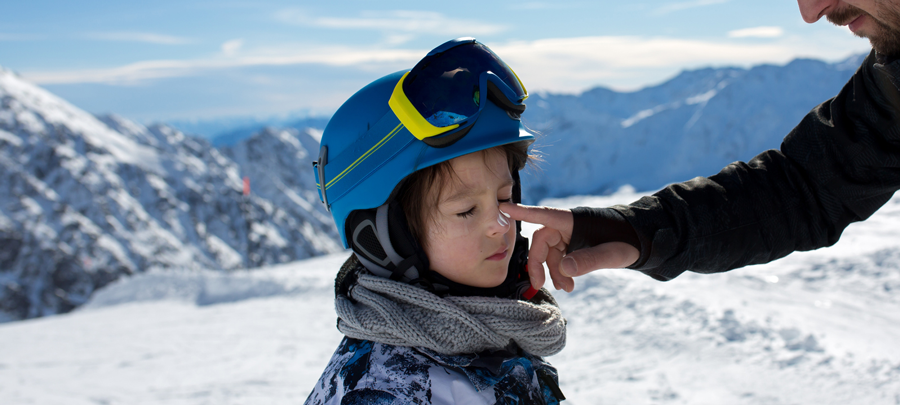Enjoy the outdoors
Central Oregon has some of the highest rates of skin cancer in the country, thanks to our abundant sunshine and high altitude. Here’s what you can do to protect yourself:
- Wear sunscreen with sun protection factor (SPF) 30 or higher. “Broad-spectrum” provides protection from both ultraviolet A (UVA) and ultraviolet B (UVB) rays. Reapply approximately every two hours, even on cloudy days, and after swimming or sweating.
- Keep covered. Wear protective clothing, such as a longsleeved shirt, pants, a wide-brimmed hat and sunglasses, when possible. It is best if the clothing has a rating of UPF 50 to ensure appropriate sun protection.
- Avoid being outdoors during the brightest parts of the day (usually 10 a.m. – 2 p.m.) as much as you can. If you are outside and your shadow appears shorter than you are, seek shade when possible.
- Use extra caution near water, snow and sand because they reflect and intensify the damaging rays for the sun, which can increase your chances of sunburn.
Avoid tanning beds
Ultraviolet light from the sun and tanning beds can cause skin cancer and wrinkling. If you want to look tan, consider using a self-tanning product or spray, but continue to use sunscreen with it.
Avoid sunburn
Sure it hurts, but what’s so bad about a sunburn?
Sunburn means your skin has been damaged. Ultraviolet light enters the skin to damage your cell’s DNA (your body’s instruction manual). Repeated exposure to ultraviolet light can cause a lot of problems:
- wrinkles
- brown spots
- eye problems
- moles
- saggy skin
- skin cancer
In the United States, more than 3.5 million new cases of skin cancer are diagnosed annually and one person dies from melanoma every hour. Examine your skin monthly and report any changes to a dermatologist as soon as possible.
Then if it is skin cancer, you will have the best chance of it being diagnosed in its earliest, most treatable stage.
The A-B-C-D-E of skin cancer
A sunburn can increase the number of moles on your body. While moles are common, they can become cancerous.
Keep an eye on your moles with the “ABCDE” rule and talk with a health care provider if you notice anything abnormal.
| | Asymmetry - one half is unlike the other half. |
| | |
| | Border - An irregular, scalloped or poorly defined border. |
| | |
| | Color - Is varied from one area to another, has shades of tan, brown or black, or is sometimes white, red or blue. |
| | |
| | Diameter - Melanomas are usually greater than 6mm (the size of a pencil eraser) when diagnosed, but they can be smaller. |
| | |
| | Evolving - A mole or skin lesion that looks different from the rest or is changing in size, shape or color. |
Sun awareness for kids
- Minimize summer sun exposure between 10 a.m. – 2 p.m.
- Wear a wide-brimmed hat, sunglasses and UV protective clothing. Even while swimming, wear a UV swim shirt
- Apply sunscreen that provides UVB and UVA protection with a sun protection factor (SPF) of at least 30
- Apply sunscreen 30 minutes BEFORE sun exposure and reapply after swimming or excessive sweating
- Seek shade
- No tan is a good tan
- Avoid tanning beds
Below are some facts about skin cancer and children’s risk factors:
- Approximately 40 to 60 percent of sun exposure occurs before age 20
- Sunburns can happen within 15 minutes of being in the sun, but redness and discomfort may be noticed for a few hours later
- Melanoma accounts for approximately 7 percent of all cancers diagnosed in 15 to 19 year olds
Sunscreen with the term “baby” means it contains only these active ingredients:
- Titanium dioxide
- Zinc oxide
These ingredients are less likely to irritate a baby’s sensitive skin.
The AAD recommends the following when using sunscreen on babies and toddlers
Children younger than 6 months of age:
- Protect their skin from the sun by keeping them in the shade and dressing them in long-sleeved shirts, pants, wide-brimmed hats and sunglasses while taking care to prevent them from overheating
- If possible, avoid using sunscreen on these children
Children 6 months of age and older:
- Use a sunscreen that contains zinc oxide or titanium dioxide, which is most appropriate for the sensitive skin of infants and toddlers
- Even when using sunscreen, keep children in the shade and dress them in clothing that will protect their skin from the sun, i.e., long-sleeved shirts, pants and wide-brimmed hats
While both products provide important protection, the American Academy of Dermatology recommends buying separate sunscreen and insect repellants because:
- Sunscreen should be applied liberally and often
- Insect repellant should be applied sparingly and less often than sunscreen

